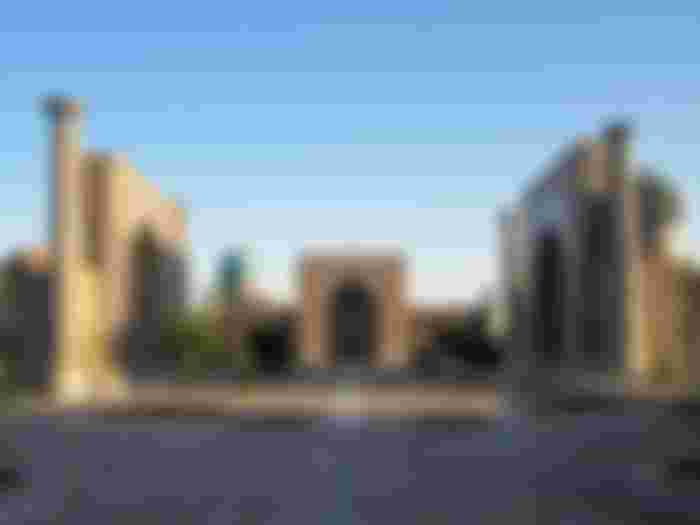If anyone asks you, which are the oldest cities in the world. Which cities will you name in the north? Rome, Athens, Babylon? But have you ever thought about Samarkand? The second largest and most important city in Uzbekistan was founded in the contemporary period of Rome and Babylon. The 2,750-year-old Samarkand has witnessed many changes in history. Witnessed the rise and fall of world champions such as Alexander the Great, Genghis Khan, and Timur Long.
The soil of Samarkand has also been blessed with the footsteps of many Muslim heroes during the Muslim advance. That is why Samarkand's culture is a mixture of Iranian, Indian, Mongolian, Eastern and some Western cultures. Besides being located in the center of the famous Silk Road, the culture of Samarkand has also flourished in terms of trade relations with different countries. This magnificent and well-equipped city has an amazing ability to attract all kinds of people including tourists, poets, historians. Historians and poets say of Samarkand, 'Rome of the East, the pearl of the Muslim Empire'.

There is no telling how many destructions and revivals this legendary city has faced. One ruler destroyed Samarkand and another built it. Samarkand has thus regained its lost glory. Each time it has become more beautiful, more pleasant. Today's Samarkand is undoubtedly a unique source of antiquity. Today's event is about Samarkand's glorious past and dazzling architecture.

The city of Samarkand is located in northeastern Uzbekistan, in the valley of the Zarafshan River. Samarkand is directly connected to Tashkent, the capital of Uzbekistan, and Bokhara, another historic city. The Tajik border is only 35 km from Samarkand. Away.
Samarkand in the pages of history
Samarkand was settled in those ancient times due to its convenient geographical location, favorable climate, abundance of natural springs and freshwater, easy access to food for hunting in the nearby mountains, and the flowing Jarafshan River. It is not known exactly when Samarkand was established. Archaeological research, however, suggests that it was founded in the eighth or seventh century BC. According to eyewitness accounts, Alexander the Great conquered Samarkand in 329 BC. Although Alexander's invasion initially caused some damage, it quickly rose to prominence under Greek supervision.
Samarkand was then captured by the Sassanid emperors of Persia. During the Umayyad Caliphate, the Arab Muslims conquered Samarkand under the leadership of Bir Qutaybah bin Muslim. At this time, Samarkand became a meeting place for diverse religious communities. However, many Arabs embraced Islam. Then in 1220 Samarkand witnessed the ruthless destruction of Genghis Khan. With swords and fire, Genghis Khan tore apart the arranged Samarkand. In 1370, Samarkand became the capital of the world-famous hero Taimur Long.

He rebuilt Samarkand and beautified the city. Timur was cruel to the enemy, but his affection and attraction to art deserves praise. He did not hesitate to decorate his capital with artistic architecture. After the death of Timur, his sons and grandsons ruled Samarkand. Timur's grandson Ulugbeg ruled Samarkand for about 40 years.
He was probably the most peaceful ruler in the history of Samarkand. The fourteenth to fifteenth centuries can be called the golden age of the history of Samarkand. During this time most of the city's strongholds, roads, and lovely domed buildings were built. In 1510 the Uzbeks occupied Samarkand. Samarkand then fell to the Tsars of Russia. After Uzbekistan became independent in 1991, it became part of Uzbekistan and this historic city became an important center of Uzbekistan.
Communication system
Samarkand was an important part of the famous Silk Road connecting China with the Mediterranean. In that sense, it is one of the major trading centers in Central Asia.

A railway bridge over the Amudaria River was built on May 1888 to connect the surrounding area with this important city, and Samarkand became an important center of the Trans-Caspian Railway. The first tramline was installed in the city in 2017. This ancient city has all the facilities of modern communication system.
Tradition
Like other cities in Central Asia, Samarkand has two parts; New town and old town. The new town has administrative buildings, cultural buildings and institutions of higher learning. The old part has historical installations, old shops and old houses. The magnificent architecture of the Timurid dynasty can be seen in the old part of the city. Now there is a brief description of some of the historical installations of Samarkand.
Resistance
Resistance Square is located in the heart of Samarkand. It is the main square of the city. It has a world-wide reputation as a unique example of Oriental architecture. On three sides of the courtyard are three madrasas facing the center. On both sides of the madrasas are lovely tall blue minarets.

The beautiful blue minaret on the roof of the building is also easily visible. Seeing the architectural style of this unique architecture arouses in my mind a sense of reverence for the ancient builders. Due to its historical significance and architectural style, UNESCO declared the Residence Square a 'World Heritage Site' in 2001.
The word 'resistance' means sandy desert. Earlier, today's courtyard was not here, it was an open field. Earlier people used to gather here to listen to the royal decree. Any national festival was also celebrated in this premises. Registan has become an important symbol of today's Uzbekistan.
Gur-e-Amir
A memorial built on the tombs of Gur-e-Amir Taimur Long and his successors. At first it was the madrasa of Muhammad Sultan, the grandson of Timur. After his death, the bereaved buried the body of Taimur's grandson in a corner of the madrasa and erected a memorial on it.

Later Timur, Timur's two sons and grandson Ulugbeg were also laid to rest here. The bright blue dome and blue tiles of the memorial are really interesting.

The beauty of the night is enhanced by the diverse lighting.
Bibi Khanam Mosque
Bibi Khanum Mosque is one of the largest and most spectacular structures in Uzbekistan. Bibi Khanam was the nickname of Mulk Khanam in Sarai, the wife of Timur. Some say that his wife gifted him the mosque to commemorate Timur's conquest of India. Some say it was built on Timur's own orders.

No matter who builds it, there is no doubt about its beauty and architectural peculiarities. The exterior of the mosque has geometric carvings and floral designs.
Afrasiab Museum
The Afrasiab Museum is located next to the ruins of the historic city of Afrasiab. The historical monuments of the museum tell the story of the city of Samarkand and its environs. It was built under the direction of an Armenian architect when Samarkand was under Soviet rule. The museum has a huge collection of Samarkand ancient swords, bows and arrows, coins, manuscripts and books.
Thanks to everyone for reading my article







